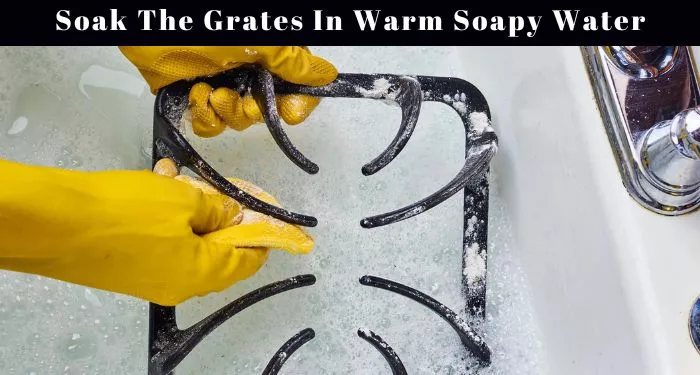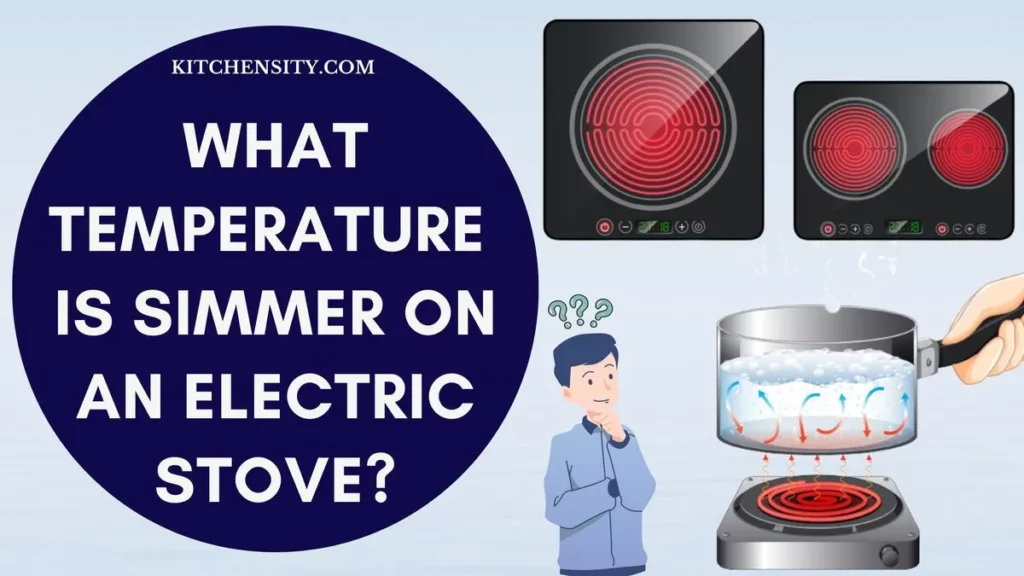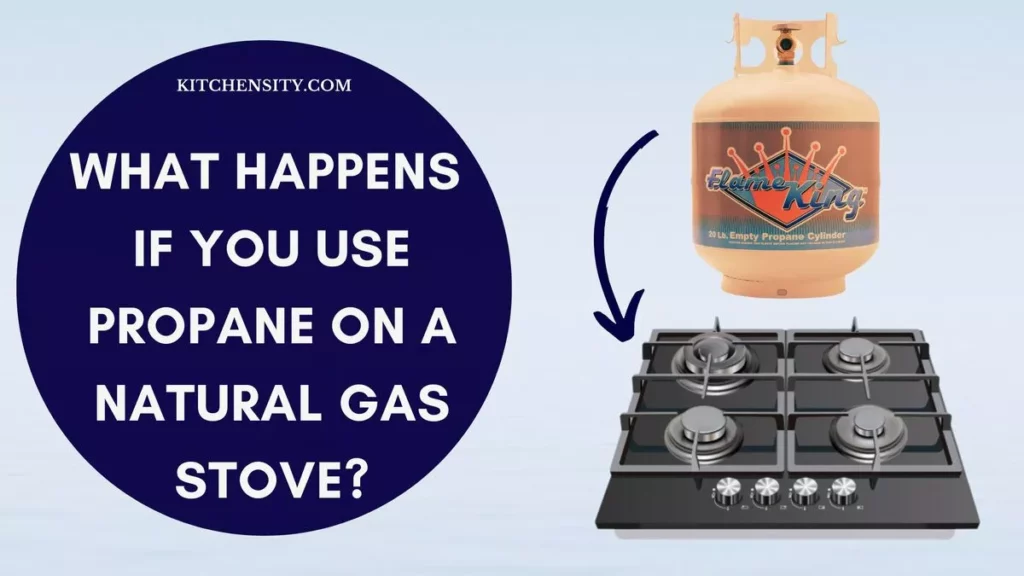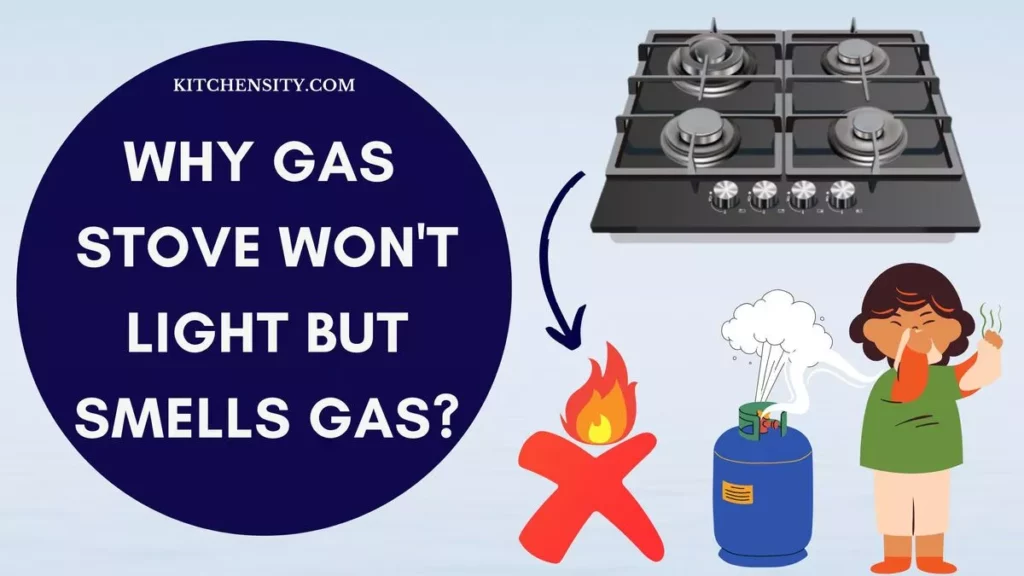Gas stoves are a popular choice in many households due to their efficiency and precision in cooking.
However, one common issue that gas stove users face is cleaning the grates. Over time, these grates accumulate grease, burnt food particles, and stubborn stains, making them challenging to clean.
In this article, we will provide you with a step-by-step guide on how to clean gas stove grates effectively, ensuring your stove remains both functional and visually appealing.

Table of Contents
- 1 Gathering Your Cleaning Supplies
- 2 How To Clean Gas Stove Grates? A Step-By-Step Guide
- 3 How To Clean Stove Grates With Vinegar And Baking Soda?
- 4 How To Clean Gas Stove Top Cast Iron Grates?
- 5 Hack For Cleaning Stove Grates
- 6 What Is The Best Cleaner For Cast Iron Grates?
- 7 What Measures Can We Take To Prevent Future Buildups?
- 8 Final Thoughts: How To Clean Gas Stove Grates?
- 9 FAQs (Frequently Asked Questions)
Gathering Your Cleaning Supplies
Cleaning your gas stove grates efficiently begins with gathering the right cleaning supplies. Here’s what you’ll need:
- Warm, Soapy Water
- Vinegar
- Baking Soda
- Toothbrush or Scrub Brush
- Dishwashing Liquid
- Soft Cloth
- Rubber Gloves
- Plastic Sealable Bag
Also Read – Why Gas Stove Grates Are Too High?
How To Clean Gas Stove Grates? A Step-By-Step Guide
To clean gas stove grates, begin by removing them and soaking them in warm, soapy water to loosen grime. Scrub the grates using a toothbrush or soft-bristled brush, then rinse thoroughly and pat dry. For stubborn stains, consider using a baking soda paste or an ammonia solution, always ensuring proper ventilation and safety precautions.
You will learn effective techniques in this step-by-step guide to clean gas stove grates, ensuring a spotless and efficient kitchen.
Step 1: Remove The Grates From The Stove
Removing the grates from your gas stove is a fundamental step in the process of cleaning and maintaining your appliance. Proper removal ensures thorough cleaning and helps in preventing any damage. Here’s a detailed guide on how to do it:
- Turn Off The Gas Supply: Safety is paramount. Begin by turning off the gas supply to your stove. Locate the gas shut-off valve, usually positioned behind the stove, and turn it clockwise to close it. This step prevents any accidental gas leaks while you’re working on your stove.
- Allow The Stove To Cool: Gas stoves retain heat even after being turned off. It’s crucial to allow the stove to cool down completely. Waiting ensures that you won’t burn yourself during the removal process. A good practice is to wait for at least 15-20 minutes after turning off the stove.
- Open The Stove Top: Most gas stoves have a hinged top that can be lifted for cleaning purposes. Locate the hinge or locking mechanism that holds the top in place. Carefully lift the top. Be mindful; it might be a bit heavy. Some stoves have support rods that automatically lift the top when unlocked. Use these mechanisms if available.
- Identify The Grates: Gas stoves typically have two sets of grates: one for the burners and another for the area above the oven. Identify the grates you want to clean. They are usually made of cast iron, porcelain-coated steel, or stainless steel.
- Lift The Grates: Once the stove top is open, you can easily access the grates. Depending on the stove model, the grates might be fitted snugly or may simply lift off. Gently lift the grates. If they don’t come off easily, check for any locking mechanisms or screws that might be securing them in place.
- Place Grates On A Flat Surface: After removing the grates, place them on a flat surface covered with newspaper or an old towel. This catchment prevents any grease, food particles, or cleaning solutions from dripping onto your floor or countertop, making the cleaning process more manageable.
Step 2: Soak The Grates In Warm Soapy Water

Soaking the grates in warm, soapy water is a crucial step in the process of cleaning gas stove grates effectively. This method helps to break down and loosen the stubborn grease and grime accumulated on the grates. Here’s how to do it:
- Prepare The Soapy Water: Start by filling your sink or a basin with warm water. The water should be comfortably warm to the touch but not scalding hot. Hot water helps in breaking down grease more effectively. Add a generous amount of dishwashing soap to the water. The soap acts as a degreaser and helps in lifting away the stubborn residues from the grates.
- Immerse The Grates: Carefully place the gas stove grates into the warm, soapy water solution. Ensure that the grates are fully submerged. It’s essential to give each grate enough space, so they are not overcrowded. Overcrowding might hinder the cleaning process, as the grates need ample room to soak properly.
- Allow For Adequate Soaking Time: Let the grates soak in the warm, soapy water for at least 30 minutes. During this time, the warm water works to soften the hardened grease and grime, making it easier to remove. The soap breaks down the oily residues, helping them detach from the surface of the grates.
- Agitate The Water Occasionally: Periodically, gently agitate the water with your hands or a soft brush. This agitation helps the soapy water reach all parts of the grates and ensures an even cleaning process. You can also use a non-abrasive sponge or cloth to wipe the grates while they are soaking. Be cautious not to scratch the grates.
- Check The Progress: After the recommended soaking time, check the grates to see the progress. You will likely notice that the grease and grime have started to loosen, making it easier to clean them further.
Step 3: Scrub Them With A Toothbrush
After soaking the gas stove grates in warm, soapy water, the next crucial step in the cleaning process involves scrubbing the intricate parts of the grates using a toothbrush or a small scrub brush. This step is essential for ensuring that all debris, grease, and grime are effectively removed, leaving the grates spotlessly clean and ready to use.
Here’s how to proceed with this step:
- Inspect The Grates: Once the grates have soaked in the warm, soapy water for the recommended duration, carefully take them out and inspect them. You might notice that the soaking process has already loosened a significant amount of dirt and grease.
- Prepare The Toothbrush Or Scrub Brush: Choose a toothbrush with firm bristles or a small scrub brush that can reach into the corners and crevices of the grates effectively. Make sure the toothbrush or scrub brush is clean and dry before you start scrubbing. Using an old toothbrush works well for this task.
- Scrub The Corners And Crevices: Focus on the intricate parts of the grates, especially the corners, edges, and crevices where grease and food particles tend to accumulate. Dip the toothbrush or scrub brush in warm, soapy water to create a soapy lather. Gently but firmly scrub these areas, applying a bit of pressure to dislodge any stubborn residues.
- Use Circular Motions: When scrubbing, use circular motions with the toothbrush or scrub brush. Circular motions help in dislodging grime effectively. Pay close attention to any visible stains or sticky spots, ensuring that you scrub them thoroughly until they are completely removed.
- Be Thorough And Patient: Cleaning the intricate parts of the grates requires patience and attention to detail. Take your time to scrub each grate meticulously, ensuring that no debris is left behind. Check different angles and rotate the grates as needed to access all sides and corners.
- Rinse And Inspect: After scrubbing, rinse the grates thoroughly under running water to wash away the loosened debris and soap residue. Inspect the grates carefully to ensure that all areas, including the corners and crevices, are clean and free from any remaining grease or grime.
Step 4: Rinse The Grates Thoroughly
The next essential step in the cleaning process is to rinse the grates thoroughly. This step ensures that all the residues, including baking soda or vinegar used in the cleaning process, are completely removed, leaving the grates clean and ready for use. Here’s how to proceed with rinsing the grates:
- Position The Grates For Rinsing: Place the scrubbed grates under a steady stream of clean, running water. This can be done in your sink or outdoors using a hose. Make sure the water pressure is sufficient to wash away all the cleaning agents and loosen debris effectively.
- Rinse All Sides: Rotate the grates under the water stream to rinse all sides thoroughly. Pay particular attention to the areas where you used baking soda or vinegar. Rinse the grates until you see no soapy residue or leftover cleaning solution. Adequate rinsing is essential to prevent any chemical residue from affecting the taste or safety of your food during cooking.
- Check For Residue: While rinsing, visually inspect the grates for any remaining residue. Sometimes, residues can be stubborn and might require a bit of extra attention. If you notice any spots that still appear dirty or feel slippery, use your fingers or a soft brush to gently scrub those areas while rinsing.
- Feel For Stickiness: Run your fingers over the grates to check for stickiness. If you detect any stickiness, it’s an indication that there might still be soap residue. Continue rinsing and lightly scrubbing until the grates feel clean and smooth to the touch.
Step 5: Finally, Dry And Reassemble The Stove Grates
After rinsing, the next crucial step is to dry them completely before reassembling them onto your gas stove. Proper drying ensures that there is no residual moisture left, preventing the formation of rust and ensuring optimal performance and safety during cooking. Here’s how to proceed with drying and reassembling the grates:
- Pat Dry With A Clean Cloth: After rinsing the grates, use a clean, soft cloth to pat them dry thoroughly. Absorb as much moisture as possible from the grates. Pay special attention to the corners, edges, and crevices where water might accumulate. Drying the grates immediately after rinsing helps prevent water spots and ensures a thorough cleaning.
- Air Drying Option: Alternatively, you can opt for air drying if you prefer a hands-off approach. Place the grates in a well-ventilated area or under a fan. Ensure that both sides of the grates receive adequate airflow. Proper air circulation speeds up the drying process and ensures that no moisture is trapped, reducing the risk of rust formation.
- Inspect For Residual Moisture: After drying, inspect the grates carefully for any signs of residual moisture. Run your fingers over the surface to feel for dampness. If you detect any moisture, continue the drying process until the grates are completely dry to the touch. Remember, any remaining moisture can lead to rust, affecting the appearance and functionality of the grates.
- Ensure No Water Spots: Check the grates for water spots, especially if you live in an area with hard water. Water spots, if left unaddressed, can become stubborn stains over time. If you notice any water spots, use a gentle vinegar solution (diluted with water) and a soft cloth to remove them before proceeding with the reassembly.
- Reassemble The Grates: Once you are confident that the grates are completely dry and free from any moisture or water spots, carefully reassemble them onto your gas stove. Ensure that each grate is placed in its correct position, aligning them properly with the burners or any supporting elements on the stove. Proper alignment ensures even heating during cooking.
- Double-Check Stability: After reassembling the grates, gently press down on them to ensure they are stable and securely in place. Check for any wobbling or loose fittings. Stability is essential to prevent accidents during cooking and to maintain the integrity of the gas stove.
- Clean The Surrounding Area: Before turning on the gas stove, take a moment to clean the surrounding area. Wipe away any residual water, cleaning agents, or debris that might have splashed during the cleaning process. A clean workspace enhances the overall cooking experience.
By following these steps, you can ensure that your gas stove grates are not only clean but also completely dry and ready for use. Proper drying and reassembly are essential for maintaining the longevity, appearance, and functionality of your gas stove grates, providing you with a seamless cooking experience.
Also Read – Why Did My Glass Stove Top Crack?
How To Clean Stove Grates With Vinegar And Baking Soda?
Cleaning stove grates with vinegar and baking soda is an effective method, especially for tackling tough stains and stubborn grime. Here’s how you can do it step by step:
Materials Needed
- Stove grates
- White vinegar
- Baking soda
- A basin or sink
- Water
- A soft-bristled brush or an old toothbrush
- Clean, dry cloth
- Rubber gloves (optional)
Steps
- Remove The Grates: Start by carefully removing the grates from your stove. Place them on a flat surface covered with newspaper or an old towel to catch any drips.
- Prepare The Soaking Solution: In a basin or sink, mix equal parts of white vinegar and water. Submerge the grates in the vinegar solution. Let them soak for at least 30 minutes. Vinegar’s acidic nature helps in breaking down tough stains and grease.
- Create A Baking Soda Paste: While the grates are soaking, create a paste by mixing baking soda with a small amount of water. The paste should be thick enough to spread easily but not too runny. Baking soda acts as a mild abrasive and helps in scrubbing away stains.
- Apply Baking Soda Paste: Take each grate out of the vinegar solution and apply the baking soda paste generously on both sides. Pay extra attention to areas with stubborn stains. Let the baking soda paste sit on the grates for 15-20 minutes. The paste will work on loosening the stains.
- Scrub With A Brush: Use a soft-bristled brush or an old toothbrush to scrub the grates. Scrub in circular motions, focusing on the stained areas. The combination of vinegar and baking soda creates a foamy reaction, which helps in lifting away the grime. Be firm but gentle to avoid scratching the grates.
- Rinse Thoroughly: After scrubbing, rinse the grates thoroughly under running water. Ensure that all the baking soda and vinegar residues are washed away. Check for any remaining stains. If stubborn stains persist, you can repeat the process or focus additional scrubbing on those areas.
- Dry Completely: Pat the grates dry using a clean, dry cloth. Ensure there is no moisture left on the grates. Proper drying prevents rust formation.
- Inspect And Reassemble: Inspect the grates to ensure they are clean and free from stains. Reassemble the grates back onto your stove once you are satisfied with the cleanliness. Ensure they are properly aligned and securely fitted.
- Maintenance Tips: To prevent future buildup, make it a habit to wipe the grates after each use. Regular maintenance can significantly reduce the effort needed for deep cleaning. Additionally, consider using stove liners or drip pans to catch spills and prevent them from reaching the grates.
By following these steps, you can effectively clean tough stains and grime from your stove grates using a combination of vinegar and baking soda, restoring them to their original cleanliness and ensuring a pleasant cooking experience.
Also Read – Do Gas Stoves Have Pilot Lights?
How To Clean Gas Stove Top Cast Iron Grates?
Cleaning gas stove-top cast iron grates requires a bit of effort, but with the right approach, you can effectively remove grime, grease, and burnt-on residues. Here’s a step-by-step guide on how to clean gas stove top cast iron grates:
Materials Needed
- Gas stove top cast iron grates
- Warm, soapy water
- Baking soda
- White vinegar
- Soft-bristled brush or sponge
- Plastic sealable bag or basin
- Rubber gloves
- Clean, dry cloth
- Cooking oil (optional)
Steps
- Remove The Grates: Carefully remove the cast iron grates from your gas stove. Place them on a flat surface covered with newspaper or an old towel to catch any drips.
- Soak In Warm, Soapy Water: Fill a basin or sink with warm, soapy water. Submerge the grates completely and let them soak for at least 15-20 minutes. The warm water and soap will help to loosen surface dirt and grease.
- Prepare Baking Soda Paste: In a small bowl, mix baking soda with a small amount of water to create a thick paste. Baking soda acts as a gentle abrasive and helps in removing stubborn stains.
- Apply Baking Soda Paste: Remove the grates from the soapy water and apply the baking soda paste onto the grates. Focus on areas with caked-on residue and stains. Let the paste sit for 15-20 minutes. The baking soda will work on breaking down the grime.
- Scrub With A Brush Or Sponge: Use a soft-bristled brush or sponge to scrub the grates thoroughly. Scrub in circular motions, paying special attention to corners and crevices. The baking soda paste will help in lifting off the dirt and stains.
- Rinse With Vinegar: Fill a basin or a plastic sealable bag with equal parts of white vinegar and water. Submerge the grates in the vinegar solution for an additional 15-20 minutes. Vinegar’s acidity will help dissolve any remaining residue and neutralize odors.
- Scrub Again (If Necessary): After soaking in the vinegar solution, scrub the grates once more with the brush or sponge. This step ensures that any remaining dirt or grease is removed.
- Rinse Thoroughly: Rinse the grates thoroughly under running water to remove any baking soda or vinegar residue. Check for any leftover stains or debris. If necessary, repeat the scrubbing and rinsing process until the grates are completely clean.
- Dry Completely: Pat the grates dry with a clean, dry cloth. Ensure there is no moisture left on the grates to prevent rusting. If you’re concerned about rust, you can lightly coat the grates with cooking oil before storing them.
- Reassemble And Season (If Required): Reassemble the dry grates back onto your gas stove. If your cast iron grates require seasoning (a thin layer of oil baked onto the surface to prevent rust), follow the manufacturer’s instructions for seasoning before use.
- Regular Maintenance: To maintain the cleanliness of your cast iron grates, wipe them down with a damp cloth after each use. Regular maintenance will prevent stubborn buildup and make deep cleaning easier in the future.
By following these steps, you can effectively clean gas stove top cast iron grates, ensuring they are free from grime and ready for your next cooking adventure.
Also Read – How To Fix A Pilot Light On A Gas Stove?
Hack For Cleaning Stove Grates
Cleaning stove grates can be a challenging task, but some effective hacks can make the process easier and more efficient. Here’s a simple and effective hack for cleaning stove grates:
Materials Needed
- Stove grates
- Ammonia
- Large plastic sealable bags
- Rubber gloves
- Warm water
- Dish soap
- Soft-bristled brush or sponge
- Clean, dry cloth
Steps
- Prepare The Bags:
- Ensure you are in a well-ventilated area and wear rubber gloves for protection.
- Place each stove grate into a separate large plastic sealable bag. You can use garbage bags or large Ziploc bags depending on the size of your grates.
- Add Ammonia: Pour a cup of ammonia into each bag, ensuring the grates are fully submerged. The ammonia will help break down grease and grime.
- Seal And Soak: Seal the bags tightly, trapping the fumes inside. Place the bags in a well-ventilated area, preferably outdoors, and let them soak overnight, or for at least 12 hours.
- Rinse With Warm Soapy Water:
- The next day, carefully remove the grates from the bags. Be cautious with the ammonia fumes.
- Rinse the grates thoroughly under warm running water to wash away the ammonia.
- Clean With Soapy Water:
- Fill your sink or basin with warm water and add a few drops of dish soap.
- Use a soft-bristled brush or sponge to scrub the grates with the soapy water. Focus on any remaining stubborn stains or residues. Rinse them with clean water.
- Dry And Reassemble:
- Pat the grates dry with a clean, dry cloth.
- Ensure there is no moisture left on the grates to prevent rusting.
- Reassemble the dry grates back onto your stove once you are satisfied with their cleanliness. Ensure they are properly aligned and securely fitted.
- Maintenance Tip: To prevent future buildup, wipe down the grates after each use with a damp cloth. Regular maintenance can significantly reduce the effort needed for deep cleaning.
This hack utilizes the power of ammonia fumes to loosen grime and makes the cleaning process less labor-intensive. Remember to handle ammonia with care, ensuring proper ventilation and protection. Always follow safety guidelines when using cleaning agents.
Also Read – What Is An Infrared Gas Stove?
What Is The Best Cleaner For Cast Iron Grates?
The best cleaner for cast iron grates is a combination of gentle yet effective cleaning agents that can remove grease, grime, and food residue without damaging the cast iron surface. Here are a few options and methods for cleaning cast iron grates effectively:
1. Warm, Soapy Water And Scrubbing
- Method: Soak the grates in warm, soapy water to loosen the grime. Use a soft-bristled brush or sponge to scrub the grates gently. Rinse thoroughly and dry completely.
- Why It Works: Warm, soapy water is a mild and safe cleaning agent for cast iron. Scrubbing helps in removing loose residues.
2. Baking Soda Paste
- Method: Create a thick paste by mixing baking soda with water. Apply the paste on the grates and let it sit for 15-20 minutes. Scrub with a soft brush or sponge, then rinse thoroughly and dry.
- Why It Works: Baking soda acts as a gentle abrasive that helps in removing stubborn stains and grime.
3. Vinegar Soak
- Method: Soak the grates in a solution of equal parts white vinegar and water for a few hours or overnight. Scrub with a soft brush, rinse thoroughly, and dry.
- Why It Works: Vinegar’s acidity helps dissolve grease and grime, making it easier to scrub off.
4. Ammonia Soak (For Heavy Duty Cleaning, Use With Caution)
- Method: Place the grates in a large plastic bag, add a cup of ammonia, seal the bag tightly, and let it soak overnight outdoors in a well-ventilated area. Scrub the grates, rinse thoroughly, and dry.
- Why It Works: Ammonia helps break down tough residues, but it should be used with caution due to its strong fumes. Ensure proper ventilation and wear gloves.
5. Commercial Cast Iron Cleaner
- Method: Use a commercial cast iron cleaner designed specifically for cast iron grates. Follow the manufacturer’s instructions for the best results.
- Why It Works: Commercial cleaners are formulated to clean cast iron without damaging the seasoning.
Tips For Cleaning Cast Iron Grates
- Avoid Harsh Chemicals: Avoid using harsh chemicals, abrasive scouring pads, or metal brushes, as they can damage the cast iron surface and remove the seasoning.
- Season After Cleaning: After cleaning, it’s essential to re-season the cast iron grates by applying a thin layer of cooking oil and heating them until the oil forms a protective layer.
Choose the method that suits your preference and ensure the grates are thoroughly rinsed and dried after cleaning. Regular maintenance and seasoning are key to keeping cast iron grates in optimal condition for cooking.
Also Read – How To Clean An Infrared Gas Stove?
What Measures Can We Take To Prevent Future Buildups?
Preventing future buildups on stove grates is essential for maintaining a clean and efficient cooking environment. Here are several measures you can take to prevent stubborn grime, grease, and stains from accumulating on your stove grates:
- Regular Wiping: Wipe down the grates with a damp cloth or sponge after every cooking session. Removing spills and splatters immediately prevents them from hardening and becoming difficult to clean later.
- Use Drip Pans Or Liners: Place drip pans or liners beneath burners to catch spills and prevent them from reaching the grates. These liners can be easily cleaned or replaced, reducing the mess on the grates.
- Season Cast Iron Grates: If you have cast iron grates, regularly season them by applying a thin layer of cooking oil after cleaning and drying. Seasoning creates a protective layer that prevents food from sticking and helps in easy cleaning.
- Avoid Boiling Over: Be mindful when boiling liquids in pots or pans. Use appropriately sized cookware and avoid overfilling to prevent spills and boil-overs that can create messes on the grates.
- Clean Spills Immediately: If spills do occur, clean them immediately after the stove cools down. Quick action prevents spills from hardening and becoming challenging to clean later.
- Use Cookware With Proper Lids: When cooking, cover pots and pans with lids whenever possible. Lids prevent splatters and reduce the chances of food particles reaching the grates.
- Regular Maintenance: Set a regular cleaning schedule for your stove grates. Whether it’s weekly or monthly, consistent maintenance prevents buildup from becoming stubborn and hard to remove.
- Avoid Harsh Cleaning Agents: Stick to mild and natural cleaning agents like baking soda, vinegar, or soapy water. Harsh chemicals can damage the grates and affect their longevity.
- Utilize Stove Mats Or Protectors: Place stove mats or protectors on the grates. These can be removed and cleaned easily, acting as a barrier between spills and the grates.
- Regular Deep Cleaning: Even if you clean regularly, perform a deep cleaning of your grates periodically. Remove them and soak or clean them thoroughly using appropriate methods to prevent stubborn buildup.
By implementing these preventive measures, you can significantly reduce the likelihood of future buildups on your stove grates, ensuring a clean and functional cooking space.
Also Read – My Gas Stove Making Noise When Off
Final Thoughts: How To Clean Gas Stove Grates?
Cleaning gas stove grates is a necessary task to maintain a hygienic and efficient kitchen. By following the detailed steps and effective techniques outlined in this article, you can ensure your gas stove grates remain spotless and ready for use. From gentle methods like warm, soapy water and baking soda to more potent solutions involving ammonia and vinegar, you have a range of options to tackle various levels of grime and grease.
Remember, prompt action is crucial. Wiping spills immediately, using drip pans, and covering pots can prevent stubborn buildups. For cast iron grates, regular seasoning with cooking oil after cleaning is essential for maintaining their longevity and non-stick properties.
Additionally, the careful use of natural cleaning agents like vinegar and baking soda, along with the innovative use of ammonia in a well-ventilated space, can effectively remove even the toughest stains. However, always handle ammonia with care and prioritize your safety.
Incorporating these cleaning practices into your regular kitchen routine will not only keep your gas stove grates clean but also enhance the overall cooking experience. With a clean and well-maintained stove, you can enjoy safe and delicious meals without the worry of unwanted residues affecting your food.
Remember: A clean stove is not just a testament to your kitchen hygiene; it’s a cornerstone of your culinary adventures.
Get ready to cook with confidence and cleanliness, making every meal a delightful experience.
Also Read – How To Fix A Pilot Light On A Gas Stove?
FAQs (Frequently Asked Questions)
-
Can I Use Oven Cleaner On Gas Stove Grates?
Yes, you can use oven cleaner, but it’s essential to follow the manufacturer’s instructions and thoroughly rinse the grates afterward to remove any chemical residue.
-
How Often Should I Clean My Gas Stove Grates?
Ideally, clean your grates once a month for regular maintenance. However, if you notice significant buildup, it’s best to clean them immediately.
-
Can I Put Gas Stove Grates In The Dishwasher?
It’s not recommended to put gas stove grates in the dishwasher, as the high water pressure and detergents might damage the grates.
-
Is It Necessary To Wear Gloves When Cleaning Gas Stove Grates?
Wearing rubber gloves is advisable, especially if you’re using strong cleaning solutions. Gloves protect your hands from chemicals and hot water.
-
Can I Use Steel Wool To Clean Stubborn Stains On Gas Stove Grates?
Yes, you can use steel wool, but be cautious not to scratch the surface of the grates. Start with a gentler scrubbing tool and move to steel wool if necessary.
🔧 Stove Expert | 🔥 Gas Guru | 🏠 DIY Enthusiast | 🎨 Painter Extraordinaire
John Davis is your go-to source for all things stoves, from expert repairs to maintenance tips. With a deep understanding of gas systems, including natural and propane, John ensures your kitchen stays cooking safely. His passion for DIY home and kitchen projects shines through his stunning paint transformations. Trust John to bring warmth and functionality to your home, one stove at a time.







